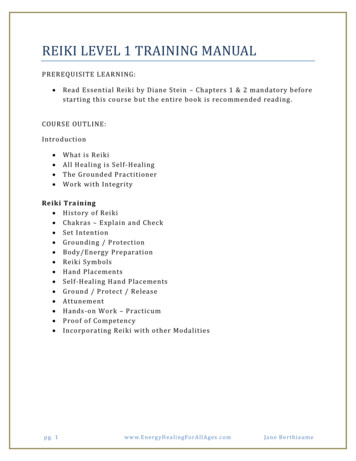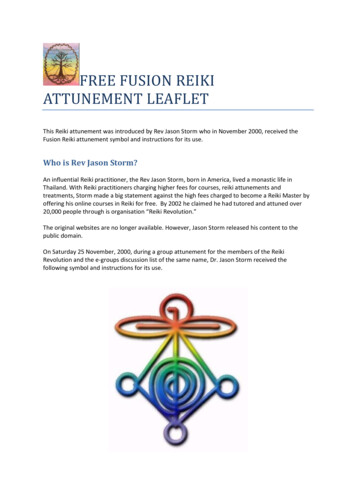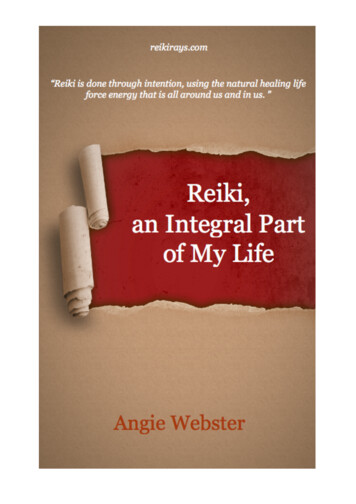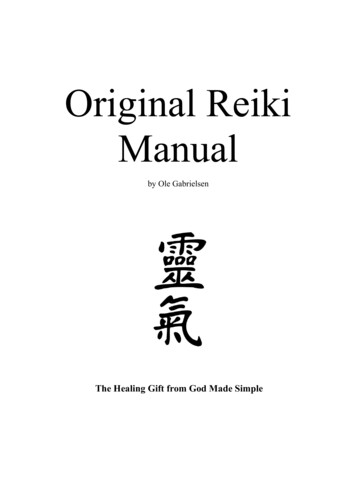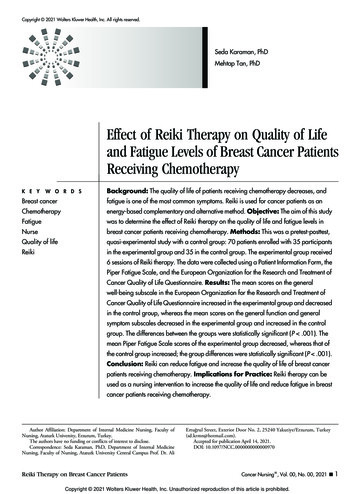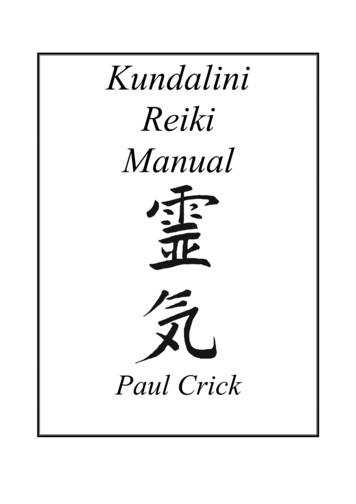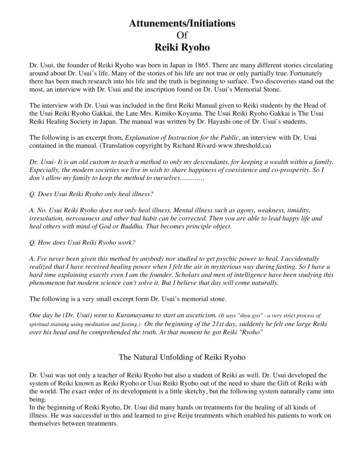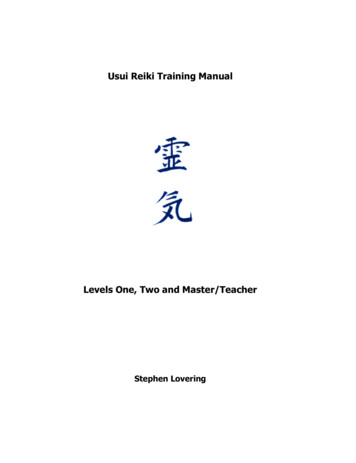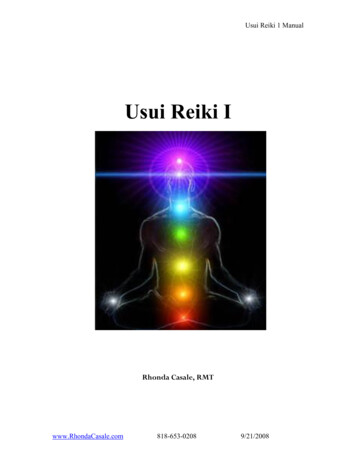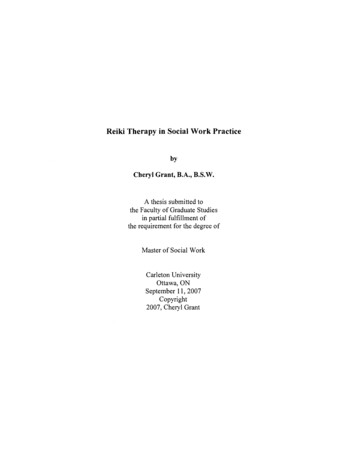
Transcription
Reiki Therapy in Social Work PracticebyCheryl Grant, B.A., B.S.W.A thesis submitted tothe Faculty of Graduate Studiesin partial fulfillment ofthe requirement for the degree ofMaster of Social WorkCarleton UniversityOttawa, ONSeptember 11,2007Copyright2007, Cheryl Grant
1*1Library andArchives CanadaBibliotheque etArchives CanadaPublished HeritageBranchDirection duPatrimoine de I'edition395 Wellington StreetOttawa ON K1A0N4Canada395, rue WellingtonOttawa ON K1A 0N4CanadaYour file Votre referenceISBN: 978-0-494-36853-4Our file Notre referenceISBN: 978-0-494-36853-4NOTICE:The author has granted a nonexclusive license allowing Libraryand Archives Canada to reproduce,publish, archive, preserve, conserve,communicate to the public bytelecommunication or on the Internet,loan, distribute and sell thesesworldwide, for commercial or noncommercial purposes, in microform,paper, electronic and/or any otherformats.AVIS:L'auteur a accorde une licence non exclusivepermettant a la Bibliotheque et ArchivesCanada de reproduire, publier, archiver,sauvegarder, conserver, transmettre au publicpar telecommunication ou par I'lnternet, preter,distribuer et vendre des theses partout dansle monde, a des fins commerciales ou autres,sur support microforme, papier, electroniqueet/ou autres formats.The author retains copyrightownership and moral rights inthis thesis. Neither the thesisnor substantial extracts from itmay be printed or otherwisereproduced without the author'spermission.L'auteur conserve la propriete du droit d'auteuret des droits moraux qui protege cette these.Ni la these ni des extraits substantiels decelle-ci ne doivent etre imprimes ou autrementreproduits sans son autorisation.In compliance with the CanadianPrivacy Act some supportingforms may have been removedfrom this thesis.Conformement a la loi canadiennesur la protection de la vie privee,quelques formulaires secondairesont ete enleves de cette these.While these forms may be includedin the document page count,their removal does not representany loss of content from thethesis.Bien que ces formulairesaient inclus dans la pagination,il n'y aura aucun contenu manquant.Canada
2Table of ContentsAcknowledgementsPage 3AbstractPage 4List of AppendicesPage 5Chapter 1: IntroductionPage 6Chapter 2: Theoretical Framework and MethodologyPage 35Chapter 3: The Potential for IntegrationPage 61Chapter 4: Barriers to IntegrationPage 97Chapter 5: Conclusions Regarding IntegrationPage 121Reference ListPage 131Appendix APage 139Appendix BPage 141Appendix CPage 143Appendix DPage 145Appendix EPage 149Appendix FPage 151Appendix GPage 154Appendix HPage 157Appendix IPage 159Appendix JPage 162
3AcknowledgementsThis project may not have come to fruition if it hadn't been for the open andgenuine nature of my thesis advisor, Sarah Todd, who encouraged me to pursue an ideathat I was interested in, despite my reservations about the parameters of mainstreamsocial work practice and research. Throughout the long and complicated process ofundertaking a thesis project, Sarah was endlessly supportive, reliable, and committed toproviding continued guidance and quality of education about research in the field ofsocial work and for this I am deeply appreciative. I would be remiss if I did not thank thepeople who so generously agreed to participate as second readers for my thesis. BettyTaylor, for her enthusiasm and support during the initial stages involved with theproposal and development of this project, and Karen Schwartz, for jumping in and just asenthusiastically agreeing to take on the role of being a second reader when Betty wasn'table to continue. This type of support was very encouraging and helped to make theprocess more enjoyable.There are many, many friends and family members that I would also like to thankfor their support, caring and encouragement, too many to list here but they are all awareof my appreciation. I would not have been able to complete this thesis without the love,support and patience of my husband, Kevin, and my son, Zachary, who both had to shareme with "the thesis" and my late nights at the computer. Last but certainly not least, Iwould like to extend my respect and sincere appreciation for the participation of theindividual professionals that I had the honour of interviewing for this project. Withouttheir interest in and passion for research, education, and the development of the fields ofreiki and social work, this project wouldn't have happened at all!
4AbstractThis study explores the perspectives of individuals with reiki and social workcredentials, or "practitioners", regarding any benefits, risks, and barriers to theintegration of reiki therapy and social work practice in the healthcare system. Anorganizational representative from each the College of Social Workers and SocialService Workers, The Canadian Reiki Association, and The Ontario HealthDepartment was interviewed regarding their response to the prospect of integrationand for the purpose of providing an organizational context to the practitioners'responses. Practitioners identified benefits to integration such as relief of physicalpain, relaxation and stress reduction, relief of emotional pain, increased mental clarityand self awareness, increased receptivity to therapy, enhanced spiritual connection,and a sense of empowerment. The fit that was described between the two practicesdemonstrated complementary goals, values, and ethics of practice. Barriers tointegration were described to be a lack of standardization in reiki and issues aroundcredibility, financial costs of reiki, lack of education and scientific research aboutreiki, a Western mind-set, and issues regarding touch in practice. Such barriersdemonstrated the impact of cultural differences and social structures due to aconservatism around the East-West paradigm clash and the struggle to establish andmaintain boundaries within both CAM groups and within the conventional medicalcommunity. None of the participants saw any risks or dangers of integrating socialwork and reiki therapy. The responses of the organizational representativesdemonstrated that the Canadian Reiki Association was very supportive of integrationwhile the College and Ontario Health Department representatives took a more neutraland formalized position. These representatives cited the importance of adhering tostandards of practice in their respective fields, which did not allow for an in-depthexploration of potential issues involved with integration.
5List of AppendicesAppendix A: Canadian Reiki Association: Code of EthicsAppendix B: Canadian Reiki Association: Disciplinary Action PolicyAppendix C: Advertisement for ParticipantsAppendix D: Interview Guide for Individuals with Reiki and Social WorkCredentialsAppendix E: Thematic nizationalAppendix F: Letter of Information for Individuals with Reiki and Social WorkCredentialsAppendix G: Letter of Information for Organizational RepresentativesAppendix H: Standards of Social Work Practice as quoted by the College of SocialWorkers and Social Service WorkersAppendix I:Letter of Consent for Individuals with Reiki and Social Work CredentialsAppendix J:Letter of Consent for Organizational Representatives
6Reiki and Social WorkChapter 1: IntroductionQuestions about healing practices often arise when people are faced with thelimits of the medical model that currently predominates in Western1 Society. People havebeen increasingly looking towards alternative treatment modalities to address physical,mental, and emotional health issues (Miles and True, 2003; Wright, 1999;http://nccam.nih.gov.health/). In the Western world, "alternative treatment modalities"fall within a category of healthcare practices referred to as Complementary andAlternative Medicine or CAM (http://nccam.nih.gov.health/). CAM practices, often basedwithin Eastern philosophical and spiritual belief systems, operate from a view of health,well-being, and healing that is holistic and that combines physical, mental, emotional,and spiritual dimensions (http://nccam.nih.gov.health/). These practices can either workin combination with conventional medicine, hence the term "complementary", or areseparate systems of healing that are used outside of or instead of conventional medicine,hence the term "alternative" (http://nccam.nih.gov.health/)2. The holistic healing modelespoused in CAM practices differs from and challenges the medical model, which reliessolely on using scientific methods to address mental and physical health concerns(Loveland-Cook, Becvar & Pontious, 2000).People seek medical treatment and social support to help manage pain resultingfrom anything from life-threatening illnesses such as cancer and HIV/AIDS to the1For the purposes of this paper, the use of the term "Western" refers to Canada, the United States, thecountries of Western Europe, Australia and New Zealand.2There are tensions within the Complementary and Alternative healthcare communities, both within andbetween the individual professions, regarding the use of the term "CAM" and regarding which professionsare identified as being part of "CAM". While I acknowledge the existence and importance of thesecontentions, this is the term and definition that I will use.
7cumulative effects of daily stressors faced by those stretching to meet the combineddemands of work and family in today's fast-paced, consumer-based society (Walsh,1999). These demands involve longer working hours, limited time with family, andjuggling finances to meet lifestyle standards set by a consumer-based paradigm (Walsh,1999). The anxiety that results from such cumulative stressors is further compounded forpeople feeling oppressed by poverty, domestic violence, language barriers, racism,ableism, sexism, and heterosexism (Lundy, 2004). Without the time or energy to managethe stress of living under oppressive conditions and the every day stressors ofcontemporary life, crises can occur that often have debilitating effects (Ell, 1996). Peopleaffected by crises may experience difficulty coping, prompting a need to rely on socialand medical support services. At times, people move beyond mainstream services andlook at alternative services such as CAM.In response to this growing interest in CAM, in this thesis I explore the benefitsand risks of incorporating reiki therapy into social work practice within the healthcaresystem. The Canadian Healthcare System is a term typically used to refer to the system ofpublicly-funded, "medically necessary" healthcare services in Canada that includehospitals, mental health institutions, community health centres, and family-based medicalpractices (http//:www.hc-sc.gc.ca/hcs-sss/alt formats).This can also include otherhealthcare services that are provided on an in-home basis or in the community but are notcovered under the Canada Healthcare Act. For the purposes of this paper, I use the term"healthcare system" to mean publicly-funded healthcare services, particularly hospitals.Reiki is a complementary therapy within the category of CAM that promoteswell-being and healing of the physical, mental, emotional, and spiritual dimensions by
8applying the concepts of energy and balance that stem from the Eastern philosophies andspiritual practices of Taoism and Buddhism (Miles & True, 2003). Current literaturesuggests that research regarding the exploration of complementary and alternativetherapies with Western mainstream social and healthcare services is timely because thereis an increasing interest in the West regarding holistic approaches to health and wellbeing (Miles and True, 2003; Wright, 1999; http://necam.nih.gov.health/) and a growinginterest in including spirituality in social work practice (Coholic, 2002; Canda, 1998;Canda & Furman, 1999; Epple, 2003).Questions about the benefits and risks of integrating reiki with social work inhealthcare are also significant because they highlight the possibilities for more effectiveservice provision to those struggling with physical, spiritual, mental, and emotionalhealth issues. In addition, I am educated in both reiki therapy and social work practiceand I have often questioned the extent of fit between these two areas of practice that usequite different methods for achieving the mutual goal of assisting people to improve theirhealth and well-being.Social work's theories and practices have continued to evolve and develop overthe past century. Its approaches are often quite flexible and adaptable to different practicecontexts (Henderson, 2000). It is the awareness of this flexibility, the above-mentionedgrowing public interest in alternative therapies, and my personal connection to socialwork and reiki that motivated me to explore the possibilities and risks of incorporatingreiki with social work practice within the healthcare system.In this study, I interviewed six individuals with both reiki and social workcredentials regarding their perspectives about the benefits, risks, and barriers involved
9with incorporating reiki and social work practice in the healthcare system. In addition tothese interviews, and for the purpose of placing the responses of the above-mentionedindividuals within an organizational or institutional context, I spoke with anorganizational representative from each the Canadian Reiki Association, the College ofSocial Workers and Social Service Workers, and the Ontario Health Departmentrespectively regarding their response to the idea of incorporating reiki and social workwithin the healthcare system. The organizational representatives' responses and thecontext they provide for the results of the interviews with the practitioners in this studywill be discussed below. Interview responses were reviewed for similarities, commonthreads, and marked differences in terms of responses to a particular question. I thenprovided an analysis of the responses in terms of the benefits, risks, and barriersdescribed, the types of responses received, and the impact of incorporation on the fieldsof reiki, social work, and the healthcare system respectively.Responses of the Organizational RepresentativesEach organizational representative was presented with questions regardingwhether or not their organizations have a position on the incorporation of reiki and socialwork practice and the nature of that position. This was done for the purpose of providinga context for the responses of the practitioners interviewed in this study to the benefits,risks, and barriers involved with the integration of reiki and social work practice in thehealthcare system. All organizational representatives saw there being a possibility ofintegration in the healthcare system and confirmed some of the challenges that suchintegration would pose.
10Not surprisingly, the representative from the Canadian Reiki Association wasenthusiastically in support of integration:We encourage the use of reiki in all fields including social work.Reiki is non-invasive and used for the Highest Good of theclient/patient. It also assists the Reiki "channel" to "tune in" to theperson/patient in a much more intuitive way, providing a deeperunderstanding of their situation without judgment and without ego.As the practitioner uses Reiki to aid in the healing process of theirpatient/client, they are also receiving healing that enables them to dotheir job in a much more balanced way with much less stress andmuch less "burnout". It is truly a win/win situation in every aspect.This representative not only highlighted the benefit of integration for clients, but also sawintegration as having a benefit to practitioners (see also Anne's comment on page 78).The above quote highlights the use of intuitive knowledge in reiki practice that is alsocommon to social work practice but usually referred to as "common sense" practice. Theother factor raised about the benefit of integration is the counterbalance that reiki canprovide to the practitioner to offset burnout which can often affect social workers in theirpractice. For the profession of reiki, integration with a well-established and respectedprofession has clear benefits.The responses of the organizational representatives from The College of SocialWorkers and Social Service Workers (hereinafter referred to in this document as "theCollege") and the Ontario Health Department were similar to each other. While they didnot oppose integration, they were concerned that practitioners be appropriately trainedand adhere to the standards of their profession (as social workers and as healthcareprofessionals). The following is an excerpt from the written response provided by thecollege, thus it is rather formal in its structure and tone:The Ontario College of Social Workers and Social Service Workersdoes not have a position on the use of reiki therapy in social work
11practice, nor does the OCSWSSW have a position on the use of anyspecific therapy or treatment modality.However, the Standards of Practice set out minimum standards ofprofessional practice and conduct for members of the OCSWSSW.For the purposes of the Social Work and Social Service Work Act,1998, and the Professional Misconduct Regulation made under theAct, these standards have been approved in a by-law and allmembers are obliged to practice in accordance with them.The College representative then proceeded to outline these obligations which can befound in Appendix "H" of this study. This response is interesting in that it emphasizesstandardization and professionalism in accordance with mainstream social work practice.The combination of the representatives' inability to participate in a telephone interview,the provision of written answers to interview questions, and the formal reference to thestandards of both the College and the Ontario Health Department did not allow for thetype of dialogue required to further explore the tensions and possibilities that may beinvolved with integrating reiki and social work in the healthcare system.Unfortunately, it was also difficult to get a sense of the College's level ofawareness regarding whether social workers may already be integrating reiki into theirsocial work practice. This information may not be available or documented at this timebut would have been interesting information to explore given Henderson's (2000) studyindicating the prevalence of social workers' use of alternative therapies in their practice.The references to professional regulations and standards of practice are to ensure thatservices are provided competently and in a manner that is not beyond the practitioner'sscope of practice. Such standards of ethical practice are consistent with those in Section12 of the Canadian Reiki Association's Code of Ethics (See Appendix "A"). They statethat:
12Members must recognize their limits of competence and must notundertake issues for which they have no training. Members will notclaim that reiki can cure, nor will they diagnose any medicalproblems or prescribe, nor will they ever advise a client to stoptaking medications, unless qualified to do so. When it is in theclient's best interests, members should refer the client on to anotherpractitioner or organization that has the training appropriate to theclient's needs.Currently registration with a regulatory body is neither mandatory for reiki practitionersor required as necessary for one to be able to engage in reiki practice or train others inreiki therapy (Miles, 2003). This factor contributes to the inconsistencies in reiki trainingand practice that will be discussed in more detail later in this chapter. There are pros andcons to this situation, if flexibility in this context had not been at all permitted, reikiwould not be as accessible a therapy as it is today (Miles, 2003). However, as indicated ina majority of the interviews conducted in this project, this flexibility leads to problemswith respect to the issue of competency and credibility, particularly given the abstractnature of reiki therapy, and can have a negative impact on how reiki is viewed in society.The organizational representative from the Ontario Health Department, due to thedepartment in which he is employed and thus knowledgeable about, could only commenton questions regarding the integration of reiki and social work in the healthcare systemwithin the parameters of regulation:We don't regulate reiki in any regard- that's currently in thepublic domain. Reiki is not a 'controlled act'. There are 13controlled acts that are determined as such because they areconsidered to be harmful or to present a risk of harm if notpracticed by a licensed trained professional authorized to thatpractice. (Examples provided by the representative included:any procedure below the epidermis; setting a bone; monitoringpregnancy; allergy treatment).Any incorporation is up to the individual practitioner as long asthey have fulfilled their College's expectations in terms of
13training and professional standards which are determined by theprofessions themselves (such as with social work in thehealthcare system).Ontario recognizes the primary importance in protection of theconsumer with that of freedom of consumer choice withhealthcare. For example, massage therapy is not a controlled act,reiki can be considered in this category as it involvesmanipulation of energy where massage therapy involvesmanipulation of tissue.Use of therapies that are not considered as harmful or identifiedas controlled acts is up to the hospital and over-seeing physicianas hospitals set their own procedures. The problem is thatanybody can perform reiki, it's whether or not a professional isregulated within their profession in order to avoid situationswhere someone is practicing reiki and recommending reiki in theplace of medical treatment versus as a complementary therapy.Here we see the construction of what is considered to be harmful practice or practicesthat present a risk of harm. It is clear that reiki does not fit within this category due to thefact that reiki does not involve any intrusion of the physical body. The position that anyincorporation is "up to the individual practitioner" unfortunately does not acknowledgethe power differential between practitioners in different fields of practice other thanmedicine in the healthcare system, the ability of medical professionals to veto integration,and the impact of the current policies and procedures regulating practice. This positionalso does not take into account the existing resistance from medical professionals that donot support the integration of CAM and that present demands for scientific research thatare difficult to meet. In short, this position does not demonstrate an in-depth knowledgeof systemic and societal barriers that would prevent integration of CAM, much less theintegration of reiki and social work in the healthcare system.In the last section of the above quote, concerns about credibility and lack ofstandardization in reiki training and practice are more clearly stated. Again we see a
14reliance on a system designed to maintain the authoritative status of its powerholders (fore.g., hospital administrators and medical physicians) who make the decisions about whattreatments are acceptable or not, particularly in the case of complementary andalternative therapies. Despite government claims to recognize and strive to meet theneeds of the public, consumer choice is still restricted by the standards set by currentpowerholders within the healthcare system.The following response illustrates what the Ontario Health Departmentrepresentative felt would have to change in order to facilitate integration of social workand reiki in the healthcare system:Again, reiki therapy would have to be considered harmful or aspresenting a risk of harm. It would be beneficial to formally regulatethe use of reiki in the healthcare system given there are so manydifferent and individual cases. Individuals may or may not want theservice, hospitals or medical professionals may want to incorporatethe therapy on a compassion basis for the client's situation andrequest - it would get clumsy. Social workers in hospitals would bepermitted to incorporate within the standards and expectations oftheir profession and in accordance with the hospital's standards.It is incongruous to abide by standards under which reiki would not be consideredharmful, while concluding that the resolution for achieving integration of reiki with socialwork in the healthcare system would necessitate the construction of reiki as harmful. Inlight of earlier discussions regarding the status of medical professionals as powerholderswithin the healthcare system and their demands for CAM therapies such as reiki toprovide scientific research, this contradiction raises the question of whose interests areultimately being served.Although the above position raises doubt regarding an unbiased position, there aresome legitimate concerns raised about the parameters of practice standards and procedure
15around service provision. The concern raised in the above quote supports that voiced bythe practitioners of this study around the problem of the lack of standardization of reikitraining and practice. However, given this concern, the primary standards that wouldneed to be considered regarding integration of reiki and social work in the healthcaresystem come back to safety and efficacy, which link back to the controversy around thedefinitions of harm, safety, and efficacy and how these are measured. In this context, theorganizational representative suggested formal regulation of reiki to facilitate thepossibility of integration.In addition to the above recommendation, there would need to be a transformationof the current role that social workers play in the healthcare system, particularlyhospitals. The current role of a social worker does not allow for the space, time, andenvironment necessary for an integrated reiki and social work service to be provided.There would also need to be changes made in policies and procedures regarding theprocess involved with the provision of integrated services within the healthcare system.Any service without some planning as to the process of service provision would getclumsy. Social workers are familiar with the breadth of diversity that comes with workingwith individuals in various situations. Social workers often have to work on a case bycase basis within the confines of the institution they work for. This is the reality ofmainstream services. What social workers can do to facilitate individualized service is totailor their approach and referral of resources to the individual and advocate for change orspecial considerations to be made when referrals to other resources are not going to beeffective. This helps to ensure that a person gets appropriate services and appropriateaccess to services. This concept is not completely foreign to a healthcare system that
16claims to be moving towards more individualized services and use of communityresources to better meet healthcare needs in a cost-efficient manner.The Evolution of Social WorkTo understand contemporary possibilities for integrating reiki and social work, itis helpful to understand the evolution of social work as a profession. The profession ofsocial work is concerned with intervening in the lives of individuals, groups ectivewell-being(www.casw acts, ca). In addition, broader social issues are targeted in an effort to evokesocial change for the overall benefit of society (Canadian Association of Social Workers:vvww.casw acts.ca; http://www.ocswssw.org, 01/04/2006). The origins of social work,beginning in the early 1900's, were rooted in religious sentiment and the quest for serviceto benefit humanity on behalf of various Christian organizations during the social gospelmovement (Canda & Furman, 1999; Wills, 1992; Richmond, 1969). The social gospelmovement was a movement within the Protestant churches inspired by Christiansocialism and operating under the concepts of interdependence, a sense of brotherhood,democracy, and social reform with regards to the marginalizing impact of a capitalistsociety (Wills, 1992). Religious institutions were the first sponsors of social serviceprograms, via the Charity Organization Society. Workers at the time were originallyreferred to as "Friendly Visitors" and shared a sense of spiritual mission (Richmond,1969). While this religious initiative may have been prompted in the spirit of helpingothers, it unfortunately also imposed religious values and judgments that may not havebeen shared by all (Canda & Furman, 1999).
17In the late 1920's there began a shift in social work practice towardsprofessionalization and secularization, and a shift away from the religious and spiritualinitiatives (Wills, 1992). Further, the gradual, interrelated processes of secularization andprofessionalization resulted in social work emulating psychiatry and its medical model(Holland, 1989) and embracing a scientific worldview (Canda & Furman, 1999;Kilpatrick & Holland, 1990). The move towards a secular practice was made on thegrounds that spirituality was viewed as unnecessary, irrelevant, and even illogical andpathological (Spencer, 1961). As the rift between secularity and spirituality grew in theinterest of achieving a clinically objective and scientifically credible therapeuticenvironment, issues pertaining to spiritual distress were viewed as being personal andprivate and to be discussed with clergy members in a spiritual or religious context(Walsh, 1999).However, in more recent years, the rigid secular nature of the profession has beenchallenged as shoring up a consumer-based economy without fulfillment (Walsh, 1999).Walsh argues that the industrial and political campaign for people to work towardsobtaining material goods to achieve success and happiness undermines the individual
This study explores the perspectives of individuals with reiki and social work credentials, or "practitioners", regarding any benefits, risks, and barriers to the integration of reiki therapy and social work practice in the healthcare system. An organizational representative from each the College of Social Workers and Social
